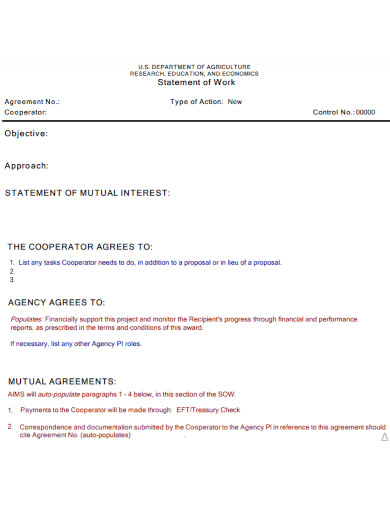Private or public agencies like travel agencies and employment agencies know they have a job to fulfill and it is to give and provide the services they offer to their clients or customers. A lot of agencies find the need to stand above the rest in order to get clients to choose them. Of course there are a lot of ways for this to happen, and one of which is an agency statement.. Write a statement for your agency that will give you the wow factor, and attract the right people to your agency. How to do that is simple, why you should is another. With that, here are examples of agency statements. Be sure to download.
[bb_toc content=”][/bb_toc]
10+ Agency Statement Examples
1. Advertising Agency Statement Template

2. Agency Statement of Work Template

3. Agency Capability Statement Template

4. Statement of Agency
5. Scientific Integrity Agency Statement
6. Claimant & Referral Agency Statement
7. Statement of Work Agency
8. Office of the State Library Agency
9. Statement of Space Agency
10. Atomic Energy Agency Statement
11. Agency Mission, Philosophy Statement
What Is an Agency Statement?
Agency statements are descriptive sentences whose goal is to explain and describe the agency, the nature of the agency, the owner or who is running it and the services or products they offer. They are also defined as written documents that provide answers to a customer or client’s complaint. These statements are for the public to see and to read in order to get an idea of what the agency is about. In addition to that, an agency statement has its own vision and mission, and the goal in which the agency writes in order for them to serve the general public. An agency statement can be short or lengthy, which will also depend on what information they are offering to the public.
How to Write an Agency Statement
Where do you begin when you want to make an agency statement? You begin with the idea of what the statement should be about. Questions like is it for advertising, for work or for space is often the biggest question you need to ask yourself before you begin with the statement. The next question is how. To get the answers you are looking for, let’s take a look at how to start writing an agency statement.
Step 1: Detailed and Concise Information
Agency statements also act as agency profiles. The details of the statement have to be clear and concise. This works when the agency you are running will be advertising in billboards or brochures. Avoid adding information in the statement that is not true to the nature of your agency.
Step 2: State the Correct and Clear Facts
Use correct and clear facts about your agency in your statement. Stating facts in your statement about your agency, may it be private or public is important. The facts help clear details of your agency to your clients. Private or public agencies know this is necessary.
Step 3: Be Sure to Make Your Statement Understandable
Avoid using difficult words or terms. These may make your statement difficult to understand. Your main purpose for the statement is to allow your clients to get clear and recognized facts about your agency.
Step 4: Check Your Facts before Moving Forward
The last step is to check every single fact you have written in your statement. Before moving forward to use your statement for advertising in billboards, brochures, or through social media sites. Always remember your agency statement can give a huge impact.
FAQs
What is an agency statement?
Agency statements are descriptive sentences whose goal is to explain and describe the agency, the nature of the agency, the owner or who is running it and the services or products they offer. They are also defined as written documents that provide answers to a customer or client’s complaint. Agency statements are used to attract clients to the agency business for a different set of purposes.
What are the kinds of statements?
There are a lot of types of statements. Statements that are used for different purposes as well. The most common statements are: statement of work or SOW, college statement, business statement, artist statement, personal statement, and income statement.
How do you write an agency statement?
To start making an agency statement, you must first understand what the nature of the statement is for. Is it for advertising, for listing down your products and services? As each statement has its own purpose and its own use. You must be sure as to what it is for.
Tourism agencies, private or public agencies know their statements make a huge impact on their business. How they present themselves to their clients and customers will also matter. If you own an agency, make sure the statement you give is true and factual to the nature of your work.











